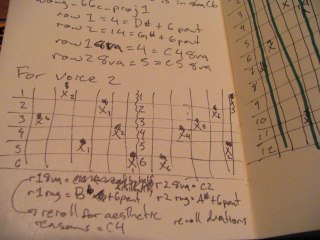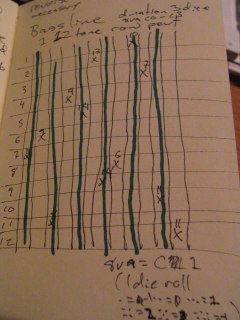1:: each of the two melodic voices have two "rows," or groups, of six tones, and the bassline has one row of twelve tones. i did this because i wanted some variety, and chance would determine in what octave each of the melodic 6 tone rows would occur, and the bassline, being the bassline, would be limited to two adjacent octaves.
2:: within each row, all notes must occur only once, and every note must occur at least once. no repetition, in other words. chance determines the order within the row, with one 6 sided die for each 6 tone row, and one 12 sided die for the bass 12 tone row.
3:: note durations would also be determined by chance, with a roll of (a) di(c)e dictating the length of each note in units of 16th notes (a single die for each of the melodic notes, and three dice for each of the bass notes).
4:: the starting note of each row, and the octave to which it belongs are also determined by chance.
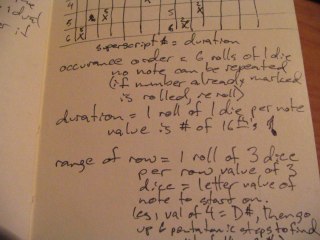
let's walk through building the first row of the first voice. you can see at the top of the page in the picture to the right that i made a correspondence between note names A-G and positive integers starting at 1 (effectively ending at 18, the max of three 6-sided dice), with the note names repeating once they were exhausted. in other words, 8 corresponds to A since there are only 7 note names, and so on.
:: i rolled the 6 sided die repeatedly to determine the order of the six tones, which as can be seen in the first grid on the prozac post-it (duplicated in the pic below it), resulted in the order 6-1-5-2-3-4. if i rolled a number that had already occured, i rerolled until all 6 numbers had occurred at least once.
:: then i rolled the 6 sided die again for each note to determine its duration. each note could have 1 to 6 16th notes' worth of duration. the results i noted with the little number next to the 'x' in the grid.
:: i next rolled three 6 sided dice, to determine the range of the row. i got a 4, which is equivalent to D in the correspondence i set up. since D is a white key on the piano, and i was using only the black keys, i used D# as the first tone of the row, counting up 6 black keys. thus, the tones for row 1 voice 1 are D#, F#, G#, A#, C#, D#.
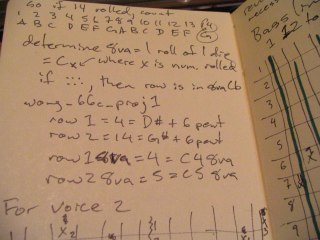
thusly, i constructed the four rows.
the fifth row, the bassline, varied slightly. i wanted to make sure it was a bassline, not by chance ending up as another voice to muddle things up. to do this thing, i imposed some further limitations on that row.
:: one row of 12 tones (effectively this only forced the row to be composed of 2 adjacent and non-identical octaves. any of the two 6 tone rows of the other voices could be in the same octave or in non-adjacent octaves). just to be nerdy, i rolled a 12 sided die.
:: limited choice in octave identity (C-1, C0, C1, C2, C3 were the only choices) i further biased the lower octaves by making a correspondence with the five available octaves to the six sided die. (in other words, both 1 and 6 corresponded to C-1)
:: three dice for durations, allowing up to 18 16ths in duration.
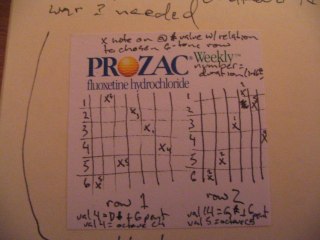
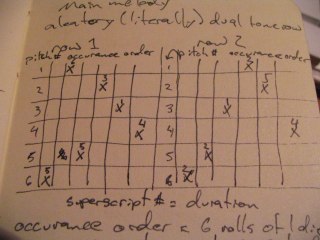
first came unsynchronized.
then, as part of an assignment to resoundtrack another assignment, i replaced the audio in my short video with a synchronized version.
moving points (original audio)
moving points (pentalea synchronized)
lastly, i rearranged the synchronized version to stand on its own, thus desynchronizing it. it is much shorter than unsynchronized, because (as usual) people who heard that version complained that it was too long.
